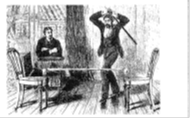In the figure below, a needle has been placed in each end of a broomstick, the tips of the needles resting on the edges of filled wine glasses. The experimenter strikes the broomstick a swift and sturdy blow with a stout rod. The broomstick breaks and falls to the floor but the wine glasses remain in place and no wine is spilled. This impressive parlor stunt was popular at the end of the nineteenth century.
What is the physics behind it?


